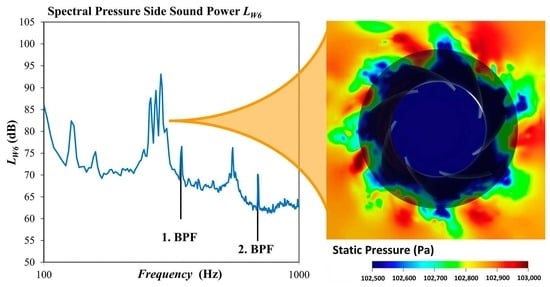Investigations concerning the Flow Stabilization of Backward Curved Centrifugal Impellers at Low Flow Rate
Abstract
:1. Introduction
2. Experimental Investigation
2.1. Configuration Description
2.2. Experimental Results
3. Numerical Investigation
3.1. Numerical Setup
3.2. Numerical Results
3.3. A Modal Analysis of the Flow Structures Based on Numerical Results
- A 1st kind of distinct rotating structures can be observed at Ωr = 100 % (very right point in each graph). These are the expected co-rotating structures directly issued from the blades. Moving away from the blade, rotating structures at this Ωr decrease rapidly.
- A 2nd kind of significative rotating structures can be observed, which has its maximum at Ωr ≈ 20 % (for the given particular impeller). Near the blade trailing edge at d = 1.0 D and d = 1.1 D ((a) and (b)), the amplitude of the fluctuation increases significantly with decreasing volume flow rate QV. The rotating structures have at a diameter of the blade trailing edge an important strength, especially for lower volume flow rates QV (Figure 6a, comparison of the three operation points).
- Moving radially further from the blade trailing edges, the strength of the rotating fluctuations with Ωr = 20 % increases and dominates over the 1st kind of fluctuations that co-rotate with the impeller.
- The rotating frequency of the fluctuations is not concentrated sharply at Ωr = 20 %, but has a significant dispersion, similarly to the broad shape of the subharmonic humps in the acoustic spectra.
- At d = 1.4 D, the strength of the rotating structures for QV = 2500 m3/h already decreases, whilst the strength of the rotating structures for QV = 3500 m3/h still increases. The rotating structures come closer to the blade trailing edges when reducing the volume flow rate. This may be observed qualitatively also in Figure 4.
4. Fan Optimization
4.1. Numerical Investigations of Geometrical Modifications on the Downstream Side
4.2. Experimental Data of an Implementation
5. Conclusions
Author Contributions
Funding
Informed Consent Statement
Data Availability Statement
Conflicts of Interest
References
- Kameier, F.; Neise, W. Experimental Study of Tip Clearance Losses and Noise in Axial Turbomachines and Their Reduction. J. Turbomach. 1997, 119, 460–471. [Google Scholar] [CrossRef]
- Mongeau, L.; Thompson, D.E.; McLaughlin, D.K. Sound Generation by Rotating Stall in Centrifugal Turbomachines. J. Sound Vib. 1993, 163, 1–30. [Google Scholar] [CrossRef]
- Zhu, T.; Lallier-Daniels, D.; Sanjosé, M.; Moreau, S.; Carolus, T. Rotating coherent flow structures as a source for narrowband tip clearance noise from axial fans. J. Sound Vib. 2018, 417, 198–225. [Google Scholar] [CrossRef]
- Bhatnagar, P.L.; Gross, E.P.; Krook, M. A Model for Collision Processes in Gases. I. Small Amplitude Processes in Charged and Neutral One-Component Systems. Phys. Rev. 1954, 94, 511–525. [Google Scholar] [CrossRef]
- Chen, S.; Doolen, G.D. Lattice Boltzmann method for Fluid Flow. Annu. Rev. Fluid Mech. 1998, 30, 329–364. [Google Scholar] [CrossRef] [Green Version]
- Marié, S. Etude de la méthode Boltzmann sur Réseau pour les Simulations en Aéroacoustique. Ph.D. Thesis, Université Pierre et Marie Curie, Paris VI, Paris, France, 2008. [Google Scholar]
- Chen, H.; Filippova, O.; Hoch, J.; Molvig, K.; Shock, R.; Teixeira, C.; Zhang, R. Grid refinement in Lattice Boltzmann methods based on Volumetric Formulation. Phys. A Stat. Mech. Its Appl. 2006, 362, 158–167. [Google Scholar] [CrossRef]
- Pérot, F.; Kim, M.S.; Moreau, S.; Henner, M.; Neal, D. Direct Aeroacoustics Prediction of a Low Speed Axial Fan. In Proceedings of the 16th AIAA/CEAS Aeroacoustics Conference, Stockholm, Sweden, 7–9 June 2010. [Google Scholar]
- Fares, E. Unsteady flow simulation of the Ahmed ref. body using a Latt.-Boltz Approach. Comp. Fluids 2006, 35, 940–950. [Google Scholar] [CrossRef]
- Wolfram, D.; Carolus, T. Experimental and Numerical Investigation of the Unsteady Flow Field and Tone Generation in an Isolated Centrifugal Fan Impeller. J. Sound Vib. 2010, 329, 4380–4397. [Google Scholar] [CrossRef]
- Sturm, M.; Sanjosé, M.; Moreau, S.; Carolus, T. Aeroacoustic Simulation of an Axial Fan including the Full Test Rig by using the Lattice Boltzmann Method. In Proceedings of the Fan 2015 Conference, Lyon, France, 15–17 April 2015. [Google Scholar]
- Towne, A.; Schmidt, O.T.; Colonius, T. Spectral proper orthogonal decomposition and its relationship to dynamic mode decomposition and resolvent analysis. J. Fluid Mech. 2018, 847, 821–867. [Google Scholar] [CrossRef]










Publisher’s Note: MDPI stays neutral with regard to jurisdictional claims in published maps and institutional affiliations. |
© 2022 by the authors. Licensee MDPI, Basel, Switzerland. This article is an open access article distributed under the terms and conditions of the Creative Commons Attribution (CC BY-NC-ND) license (https://creativecommons.org/licenses/by-nc-nd/4.0/).
Share and Cite
Lörcher, F.; Hub, S.; Sanjosé, M.; Moreau, S. Investigations concerning the Flow Stabilization of Backward Curved Centrifugal Impellers at Low Flow Rate. Int. J. Turbomach. Propuls. Power 2022, 7, 37. https://doi.org/10.3390/ijtpp7040037
Lörcher F, Hub S, Sanjosé M, Moreau S. Investigations concerning the Flow Stabilization of Backward Curved Centrifugal Impellers at Low Flow Rate. International Journal of Turbomachinery, Propulsion and Power. 2022; 7(4):37. https://doi.org/10.3390/ijtpp7040037
Chicago/Turabian StyleLörcher, Frieder, Sandra Hub, Marlène Sanjosé, and Stéphane Moreau. 2022. "Investigations concerning the Flow Stabilization of Backward Curved Centrifugal Impellers at Low Flow Rate" International Journal of Turbomachinery, Propulsion and Power 7, no. 4: 37. https://doi.org/10.3390/ijtpp7040037





